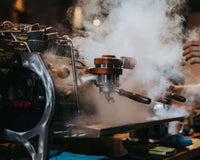The La Marzocco Strada is lovingly called the Ferrari of espresso machines. A highly programmable espresso machine that can handle the busiest of workflows—pulling perfect shot after perfect shot no matter how many customers walk through the door.
The La Marzocco Strada is an advanced espresso machine known for its iconic look, impeccable build quality, and just how easy it makes pulling a seriously good shot of espresso.
But the Strada is a top-of-the-line espresso machine. You need to be certain La Strada is the right one for you before you commit.
That’s why we sat down with Mike Walker. This expert barista has been in the coffee industry for over ten years and is currently over at Epoch Coffee in Austin, Texas. He’s worked on the Strada for years. When we got curious about this machine, we knew he was the man to ask.
We talked about:
- The La Marzocco’s best features and whether it’s right for your coffee shop
- How La Marzocco makes training new baristas a breeze
- What it takes to keep the La Marzocco running hiccup-free long-term
Let’s get started.
The La Marzocco Strada Espresso Machine: An Overview
The La Marzocco Strada was developed by a team of thirty baristas from outside the La Marzocco family. This rag-tag team of coffee experts were brought on to design a new machine, given a blank slank and license to get creative. La Marzocco nicknamed these consultants “the street team” or Strada.
This machine is what they came up with. They named it La Marzocco Strada in their honor.
The Strada is unique in how it uses a conical vale and paddle to put the barista in full control over the water flow and pressure. It allows for pre-infusions on one grouping even while the others are pulling coffee.
Each grouping has an independent boiler. That lets baristas brew multiple coffees at different temperatures at the same time. Depending on the model, nearly everything is programmable (temperature, recipes by volume or weight, etc) and easy to update as your menu or beans change throughout the year.
Other key features include:
Available Modifications
There are several modifications and options available so the La Strada can fit right in with your coffee shop's requirements. Such as:
Functional Configurations
Choose from EP (electronic paddle), AV (Auto-Volumetric), MP (Manual Paddle), and EE (Semi-Automatic).
Model Size
The La Marzocco Strada is available in 2 or 3 group models.
Colors & Finishes
If you’re looking for a custom color or finish these are available on request.
Colors are based on the RAL system.

Check out the latest prices for the La Marzocco Strada right here.
A Veteran Barista Spills The Beans on the La Marzocco Strada Espresso Machine
Barista Mike Walker has worked on a lot of different coffee machines during his time with Epoch Coffee. We asked him what it was like working on the La Marzocco Strada, and whether he’d recommend it to someone opening up their first coffee shop.
How do first-time baristas do on the machine?
“La Marzocco is a really cool-looking espresso machine. Like a little race car—they have this retro look to them. So folks are usually really excited to work on it.
The Strada makes training new baristas a whole lot easier. I appreciate the Strada for teaching because of the open design…I can actually stand above or over or even around on the other side of the machine and I can see what the barista is doing.”
How does the machine do with large rushes? Average day?
“As long as the water is flowing, the machine is going to do just fine. I've never had any issues. If the water is hot and flowing, the machine keeps up. It's very sturdy.
There’s no warm-up period in the morning—if the machine is on it’s ready to go. There's really nothing you have to do to get it to wake up. I'm pretty impressed.”
Are there any features of the Strada that contribute to an effective workflow?
“I find that the low profile of the machine really helps with your workflow. If someone were to open a brand new shop they’d have to think—where’s my workflow going to be? Am I grinding on the right and brewing and steaming on the left? Or will it be the opposite?
And because the Strada has such a low profile that’s able to fit wherever you want it, or inspire you to put it in a certain place.”
How are the machine’s ergonomics for baristas?
“It actually comes down to the height of the countertop you have in your cafe. I love the shape of the Strada but I do prefer it when it’s on a low counter.
A lower counter just means you’re using different shoulder muscles. You’re not getting worn out as much. It’s especially nice being able to look down and see what you’re brewing rather than staring at the top of an espresso machine.”
What should first-time users know about using this machine?
“I always tell first-time users to think about what they’re making and what they want the finished product to be. If you’re making a latte, break it down. First focus on the espresso, then the milk. Don’t stress about the next step while you’re in the middle of the first step.
I don’t think there’s anything about the Strada particularly vital for new users to know—just be familiar with it, get to know it. How do the portafilters lock, etc. Every machine is slightly different with small things like that.”
What is the standard maintenance timeline for the machine?
“The Strada is really easy to maintain. You can quickly change the screens, the group head, and the portafilter as needed every three months for preventative maintenance. Plus it’s really easy to swap out the gaskets.
You just have to watch a video to see what it looks like or have someone show you in person. The only other maintenance that's done daily is cleaning. And that's kind of just like your standard barista skills that you learn regardless of your level—how to perform a backflush etc.”
What's it been like implementing repairs without a technician? Is this something the staff can do?
“I wouldn’t worry about getting on the insides of the machine unless you're trying to pursue a more technical career route in coffee. The daily maintenance is easy and the stuff you can access on the outside that needs to be changed every three to six months is really easy as well.
Everything else? Unless you’re pursuing a more technical career it’s probably not necessary to bother about it. It’s all under the hood of the espresso machine. Save it for the professionals.”
Can you describe some of the common problems you’ve experienced with this machine?
“There's nothing unexpected that really comes up. Other than that you should expect to replace all the rubber parts in your steam wand every six months. But that's just part of the life of an espresso machine.”
In combination with a quality grinder, how does the espresso pulled and milk steamed from this machine compare to others you’ve used throughout your career? Do any specific machine features contribute to drink quality?
“I feel like the magic is in the preparation of the puck by the barista, and the quality of the pressure provided by the machine. I haven't found anything particularly extra about the Strada versus say the La Marzocco GB 5.
It's just a matter of making sure your equipment is maintained and your baristas are trained to know what to look for to provide a quality experience. You can usually coax magic out of anything, to be honest.”
Is there anything else that someone who’s considering buying this machine should know before they commit?
“Just be aware that it's a very wide machine. It's a low-profile machine so consider how that fits into the workflow of your coffee shop and how your baristas are going to be using it.
The Strada looks great and I really enjoy my work experience on it. Buyers should keep in mind it takes up more counter space and is a low-profile machine. Assuming you’re running a busy place your baristas are going to be on this for, hopefully, large chunks of your day. So knowing the height and profile of your machine is key for maximizing the workflow”
The La Marzocco Strada Espresso Machine: In Review
The La Marzocco Strada is a powerhouse of an espresso machine, made by baristas for baristas. Some call it the Ferrari of coffee machines: powerful and beautiful to look at, but with a price point to match.
Before you buy it’s best to familiarize yourself with the pros and cons.
|
PROS |
CONS |
|
Its design profile lets customers and baristas see each other which creates a unique coffee shop experience. |
It’s a wide unit that takes up a lot of counter space. Might not be suited for some coffee shops where space is at a premium. |
|
Conical Valve System and Pump allows progressive water control. |
It's not called the Ferrari of espresso machines for nothing—the relatively high price point is in-line with the machine's performance. |
|
Separate independent boilers allow for better workflow, especially if you have a complex menu. |
|
|
A reliable machine known for keeping on going, so long as the basic daily and monthly maintenance is performed. |
|
|
Auto Backflush and ruby flow restrictors prevent scale build-up and keep it functioning for longer. |
The La Marzocco Strada is great for coffee shop owners that want an espresso machine to:
- Stay on top of the crowd. As long as the water is flowing the Strada is pulling perfect shots.
- Retain value. It not only looks good but it’s got a reputation as one of the best espresso machines on the market.
- Train new staff on. Its unique low-profile makes onboarding new baristas easier than other espresso machines.
Ready to try the only espresso machine designed by baristas for baristas? Check your options right here. If you have any questions, don’t hesitate to reach out—our team of coffee industry experts are on hand and ready to help.







